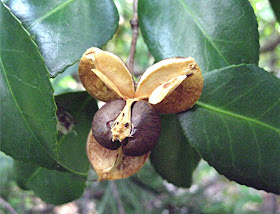

It's mid-September and plenty of fruits are coloring up. At home our large
Cornus florida has been under attack from bluejays, cardinals, and doves?! for two weeks. They swoop colorfully back and forth across the garden. The cardinals stay mostly silent, occasionally producing their charcterist call; the bluejays by contrast loud and raucous. It's a good show.
The Euscaphis at the Arboretum are a good show too. You can't miss these plants in the fall and clearly the seeds are abundant. Likely that explains why so many collecting trips have brought back seeds and in turn, why we have so many accessions. Still, it's a good plant with clearly a lot of variation. If you've got to have a lot of something, this might as well be it.
I grew a handful from seed about 15 years ago and kept one. It's now about 15 feet tall and beginning to produce good quantities of fruit. For years I worried that it was self sterile. I got lots of flowers and little or no fruit. And that's almost the best part of the plant. Anyway, starting about 5 years ago, as the plant began to attain some stature, the numbers of fruit that matured increased every year. It's nowhere near the plant above but it's getting there.
 This Corylopsis is one of the many plants that are pushing new growth in response to three weeks of rain following a hot dry summer. This morning I actually noticed flowers on the Styrax obassia in my back garden (in Adelphi). I've never seen that before. Ever.
This Corylopsis is one of the many plants that are pushing new growth in response to three weeks of rain following a hot dry summer. This morning I actually noticed flowers on the Styrax obassia in my back garden (in Adelphi). I've never seen that before. Ever.














